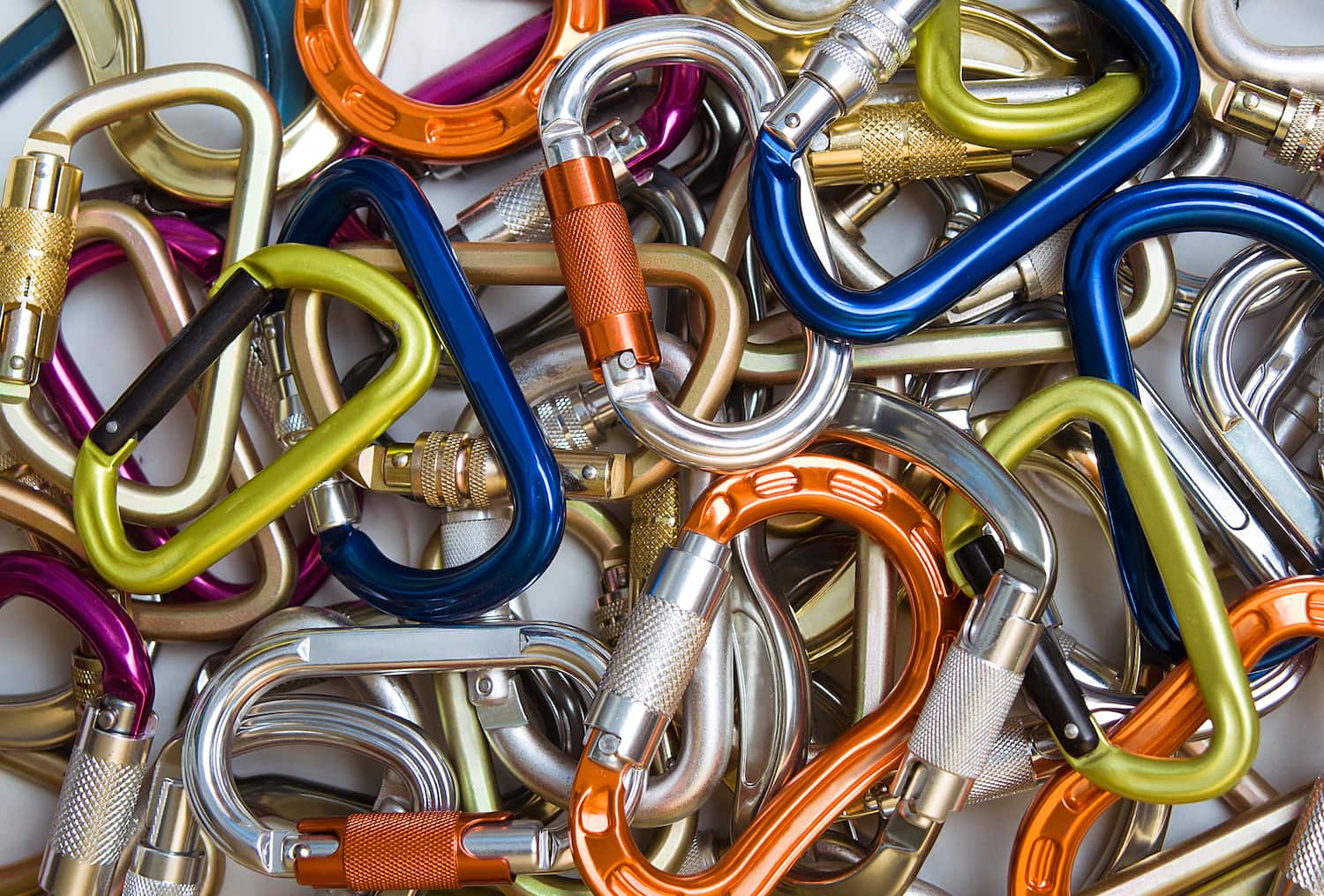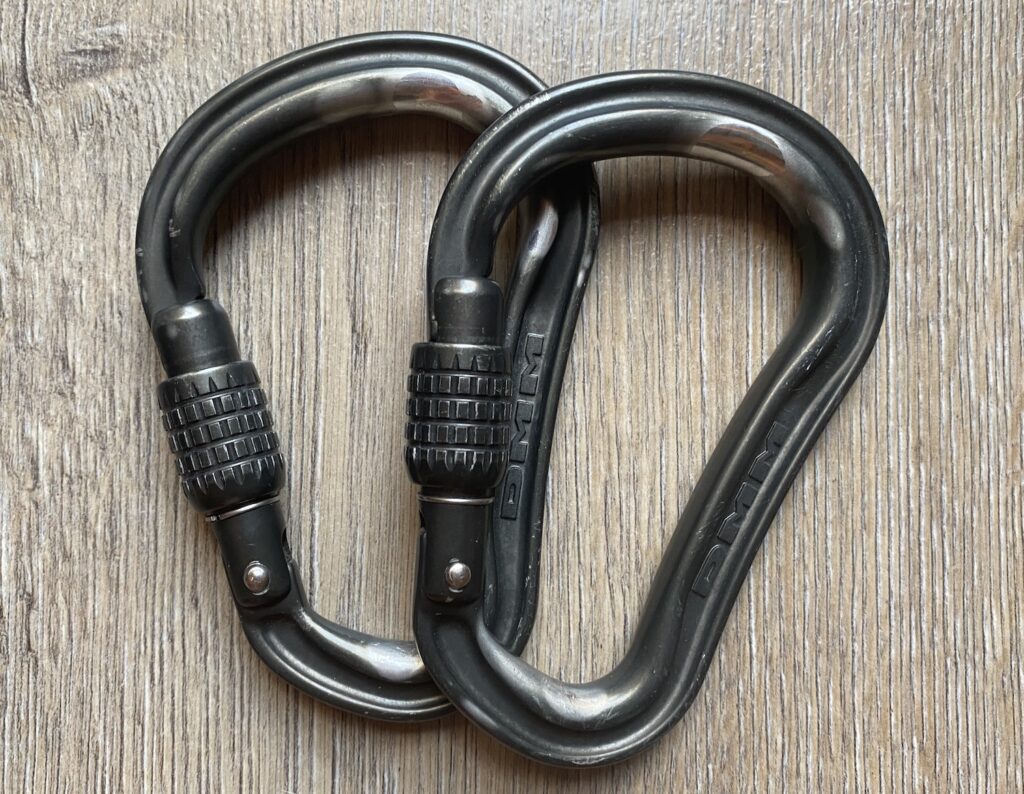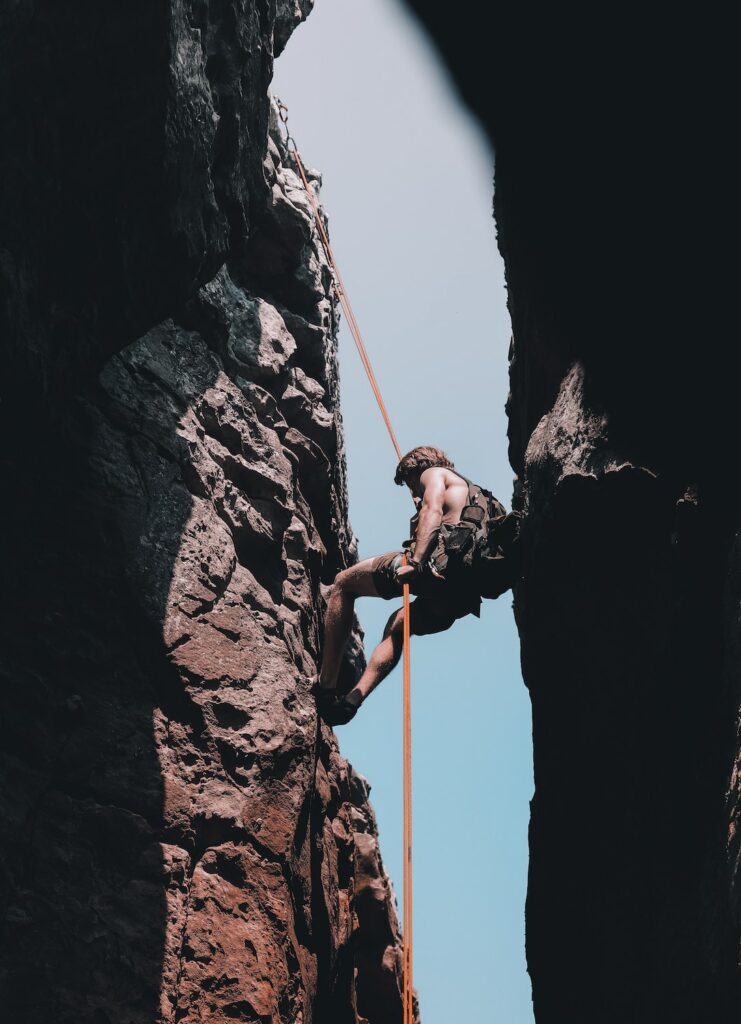When to Retire Carabiners: 5 Signs It’s Time (2023 Guide)

By Teddy Dondanville, AMGA
Over time, it’s normal for your rock climbing equipment to wear down. For example, climbing ropes develop soft spots, belay loops on harnesses get worn, and slings get fuzzy.
Although soft goods like ropes and slings are most susceptible to being retired, hard goods, like carabiners, will also wear out eventually, albeit much slower.
So, if you’ve got some gear that’s looking haggard or your climbing partner is bugging you about whether or not you inspect your gear, keep reading. Below I will share five red flags for beat-up carabiners and some tips to extend the life span of your beloved biners.
5 Signs It’s Time to Replace Your Carabiners
When you decide to retire a carabiner (1) will depend on your personal preferences regarding safety and risk management and how often you perform gear inspections.
In other words, climbers will have a different opinion on how worn their carabiners can get before they replace them. Nonetheless, here are five visible signs your carabiners may be ready for retirement.
1. Deformed or Damaged Rivots
Rivets are the carabiner gate that connects to the carabiner body. If there are missing rivets or the rivet is deformed or damaged, the gate may be unable to open or close properly. Even worse, with damaged rivets, the gate could even fall off.
2. Obvious Cracks on the Body or the Gate
Obvious damage and cracking on the carabiner that merits retirement will be visible to the naked eye. I am not talking about mythical “micro fractures” or scratches on the carabiner from regular wear and tear.
3. Deformed Carabiner Body, Gate, or Nose
Carabiners can become deformed from misuse, for example, cross-loading. If you notice that the body, gate, or nose of the carabiner is deformed, elongated, or otherwise obviously damaged, you have grounds for retirement.
4. Significant Wearing in the Basket or Crotch of the Carabiner
The most common reason for retiring carabiners is significant wearing like sharp edges, deep grooves, and burrs. Deep grooves from rope wear and sharp edges or burrs weaken the carabiner and put your rope at risk of abrasion and, worse, cutting.
5. “Sticky” Gate or Non-Functioning Locking Mechanism
Non-functioning or “sticky” gates or locking mechanisms do not open and close consistently. Typically, you can solve this problem with cleaning and lubrication. However, if your carabiner is relatively new and won’t function properly or won’t function consistently after you’ve cleaned it, it could be time to retire it.

How Long Do Carabiners Last?
How long a carabiner lasts depends on various factors. Therefore, carabiner manufacturers rarely give rigid time frames in terms of when you should retire your carabiners.
For example, most carabiners can last anywhere from 10 years to a lifetime. It all depends.
Factors that Impact a Carabiner’s Longevity
- Material: modern carabiners are either made with aluminum or steel. Both are very strong. However, aluminum is a soft material that is less durable than steel. Therefore, aluminum carabiners tend to wear faster than steel.
- Frequency of use: how often carabiners get used plays a big role in how long they will last. For example, a heavily used carabiner will run its course in a few years, while lightly used carabiners can last for decades.
- Type of Use: how carabiners are used is another important factor. For example, an aluminum carabiner you always use in your top rope masterpoint will degrade quicker than the ones you use to rack gear on your harness. A dropped carabiner should also be carefully inspected afterwards.
- Storage conditions: improper storage of carabiners can drastically reduce the longevity of carabiners, especially when the carabiners are exposed to indoor or outdoor environments where corrosion can occur.
The Risks of Using Old Carabiners
There are many risks associated with using old carabiners.
Fortunately, in most climbing scenarios, there is redundancy. Therefore, an old carabiner;s failure may result in an accident like a huge fall, but hopefully, the other redundancies in the system prevent anything catastrophic from occurring.
However, not everything in climbing is redundant.
For example, in most scenarios, you climb with a single rope. Therefore, in a scenario where you fall on an old carabiner with a sharp edge in the basket from rope wear, there’s a chance your rope could be cut, and a catastrophic accident could occur.
Luckily, the risks associated with using old carabiners can be drastically mitigated with proper inspection.

How to Care for Carabiners
For the most part, carabiners are robust and durable pieces of climbing equipment that last a long time when properly used. Nonetheless, there are some things you can do to help your carabiners last even longer.
- Store them properly: keep your carabiners away from corrosive materials and chemicals. Storing gear inside containers in an isolated area away from temperature swings, UV light, and chemicals is the safest place.
- Keep your rope clean: ropes pick up dirt and debris that can degrade your carabiners and shorten their longevity. Use a rope tarp when climbing, and regularly clean your rope throughout the climbing season.
- Clean and lubricate them regularly: clean your carabiners with hot soapy water. Using a mild soap without added bleach, chlorine, or degreaser is ideal. Afterward, lube the carabiner’s mechanical parts (i.e., rivet pin, locking mechanism) with a wax or Teflon-based lubricant. Avoid oil-based lubes.
- Remove small burrs: you don’t need to retire a carabiner because it develops a small burr. But you should remove the burr so it cannot abrade your rope. You can use extra fine sandpaper to remove the burr. Never use a file or anything electrical. If the burr cannot be removed with extra fine sandpaper, you may need to retire it.
What to Do with Retired Carabiners
After you decide to retire a carabiner, you must decide what to do with it– recycle, reuse, or trash it.
Recycling Old Carabiners
It’s important to know that retired carabiners cannot be thrown in your household recycling. Even though most carabiners are made of aluminum, which is recyclable, most municipal recycling operations cannot handle the color anodization of carabiners.
Therefore, if you want your old carabiners to be recycled, the best thing to do is take them to a scrap metal yard.
Reusing Old Carabiners
Just because a carabiner is not working correctly and is no longer safe for climbing does not mean that you cannot use it for other non-climbing-related purposes.
For example, retired carabiners can be used for:
- Holding other climbing equipment in a gear closet
- Hanging outdoor gear in the garage
- Hanging a hammock in the backyard
- Attaching clothes in the closet
Disposing of Old Carabiners
Apart from that, after you retire a carabiner, the last thing to do is dispose of it in the trash. If you do dispose of old carabiners, it’s best practice to destroy them so that they cannot possibly get into the hands of a curious person wanting to use them again.
Final Thoughts About Retiring Carabiners
Carabiners are a critical component in the climber’s rack of gear. Over time, carabiners will wear out and need to be replaced.
Factors that impact a carabiner’s longevity are its material, how often it’s used, and how it’s stored and maintained.
With proper usage, storage, and maintenance, climbing carabiners can last for decades. However, with severe wear and tear, unnecessary exposure to corrosive materials, or improper usage, the lifespan of a carabiner can be drastically reduced.
Therefore, inspect your carabiners regularly (along with the other pieces of climbing gear (2) you use), and if you’re very worried about the reliability of your carabiners, play it safe by retiring and replacing them.
References
UIAA Safecom Answers Your Questions: Retiring Carabiners
International Climbing and Mountaineering Federation (UIAA), Jan 2022
https://theuiaa.org/uiaa/uiaa-safecom-answers-your-questions-retiring-carabiners/
UIAA Guide To Buying Climbing Gear
International Climbing and Mountaineering Federation (UIAA), Apr 2019
https://theuiaa.org/safety/buyingclimbinggear/
